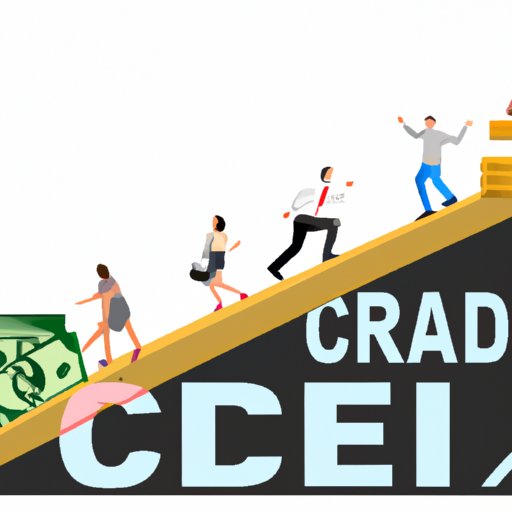
Introduction
As a small business owner, you may have heard of the term “line of credit” but wonder what it truly means and how it can help your business. In simple terms, a business line of credit is a flexible, revolving credit account that allows you to borrow money up to a certain limit and pay interest only on the amount you have used. It can be a great financial tool for small businesses to manage cash flow, cover unexpected expenses, or seize growth opportunities. In this article, we will define what a business line of credit is, discuss its main features and benefits, compare it to other forms of small business financing, provide some real-life examples of how it can be used, and share some tips on how to apply and use your line of credit responsibly.
Defining a Business Line of Credit: All You Need to Know
A business line of credit is a type of financing that provides a small business with access to a certain amount of credit that can be withdrawn at any time, up to a pre-determined credit limit. Unlike a loan, a line of credit allows a business to access funds intermittently, as needed. Interest is charged only on the drawn amount, and the repayment terms are typically more flexible than those of traditional loans. It may come in the form of an unsecured revolving credit line, which doesn’t require collateral, or a secured revolving credit line, which requires collateral such as property or inventory.
How Small Businesses Can Benefit from a Line of Credit
A business line of credit can provide small businesses with essential flexibility when it comes to managing their finances. Rather than borrowing a lump sum of money and repaying it with set monthly payments, a line of credit can be drawn upon as needed, providing an ongoing source of capital. This can be particularly helpful for businesses experiencing seasonality or fluctuations in sales or cash flow.
A line of credit can also be useful for small businesses that face unexpected expenses, such as equipment repairs or supplier delays. It can also be used for planned expenses, such as inventory purchases or marketing campaigns. With a line of credit, a business can access funds quickly and easily and pay interest only on the amount drawn, rather than borrowing a large amount of money upfront and paying interest on the full amount. This can help a business preserve cash flow and minimize borrowing costs.
Understanding the Differences Between a Business Line of Credit and a Loan
Although a business line of credit and a loan both provide businesses with access to funding, there are several key differences between the two. A loan provides a lump sum of money that must be repaid with interest over a fixed period of time, while a line of credit allows a business to access funds as needed and pay only for what they use. Loans typically also require more extensive documentation, such as a personal guarantee or a business plan. While loans may offer lower interest rates, they can be less flexible and may require more time and effort to apply and secure.
Practical Ways to Use Your Business Line of Credit
There are many ways that small business owners can use their line of credit to help grow and support their business. Here are some real-life examples of how businesses use their lines of credit:
- Payroll funding during a lean sales period.
- Covering emergency expenses such as equipment or vehicle repairs.
- Investing in new equipment, technology, or inventory.
- Marketing campaigns or advertising programs that have a quick turnaround.
- Juggling cash flow drains, such as accounts payable or taxes, while waiting for outstanding debts.
While a line of credit provides flexibility, it is important to use it responsibly and avoid over-borrowing. A business should have a clear plan for how and when they will use their line of credit and should only borrow what they need and can afford to repay.

The Pros and Cons of Using a Business Line of Credit
Like any financial product, a business line of credit has both benefits and drawbacks. Here are some of the most common:
Benefits:
- Provides flexibility to draw funds intermittently and as needed.
- Interest is charged only on the amount drawn, which can save money over a traditional loan.
- Helps build a credit history for small businesses that may not qualify for traditional loans.
- Can be a reliable source of short-term cash flow or business expansion.
Cons:
- May come with higher interest rates or fees.
- Overborrowing or inability to repay can lead to debt and harm a business’s credit score.
- May be more difficult to secure than other types of financing.
- Requires ongoing due diligence and management of credit utilization and interest rates.
How to Apply for a Business Line of Credit and Get Approved
Applying for a business line of credit can be a complex process, but with the right preparation and approach, small businesses can increase their odds of getting approved. Here are some basic steps to follow:
- Get all of your financial statements and documentation in order, including income statements, balance sheets, and tax returns.
- Understand the collateral options available and be prepared to offer collateral, if needed. This could include inventory, accounts receivable, or personal assets.
- Shop around for different lenders and financing options, including online lenders, banks, and credit unions.
- Apply for a line of credit before you actually need it to ensure that funds are available when you need them. This can also help establish a pattern of responsible borrowing.
To improve your chances of getting approved, focus on building a strong business credit profile, establishing good payment histories with suppliers and service providers, and building relationships with potential lenders before you need financing.
Exploring Alternatives to a Business Line of Credit for Your Business Financial Needs
Although a business line of credit can be a valuable source of financing for small businesses, it may not be the best option for every business or every situation. Here are some alternative sources of small business financing to consider:
- Invoice factoring: This involves selling outstanding invoices to a third-party financing company at a discount in exchange for immediate cash.
- Merchant cash advance: This provides upfront cash in exchange for a percentage of future sales or receipts.
- Crowdfunding: This allows businesses to raise funds through online platforms by pitching an idea and receiving contributions from multiple investors.
Each of these options has its own benefits and drawbacks, and it’s important to weigh them against each other to determine which will best meet your business’s needs.
Conclusion
A business line of credit can be a useful financial tool for small businesses looking to manage their cash flow, cover unexpected expenses, or seize growth opportunities. By understanding what a business line of credit is, how it differs from other forms of financing, and how to best apply and use it, small business owners can ensure they are making informed decisions about their financial future. Whether choosing a line of credit or an alternative financing option, seeking expert advice and guidance can help ensure that a small business owner is making the best financial decisions for their business.





